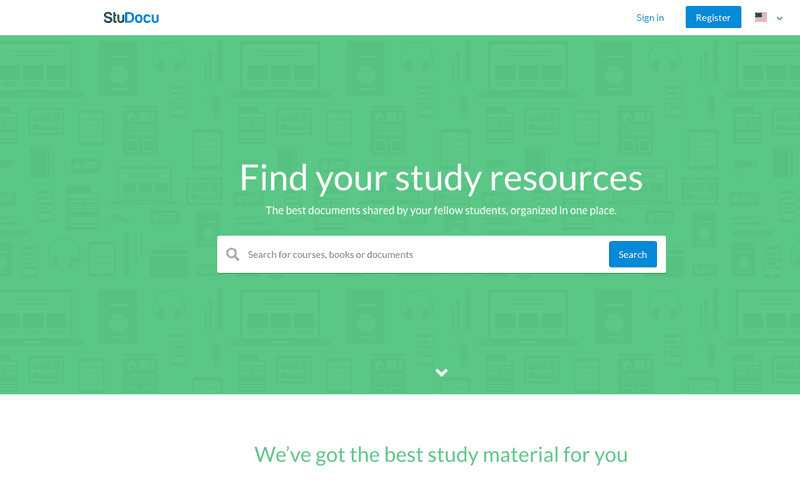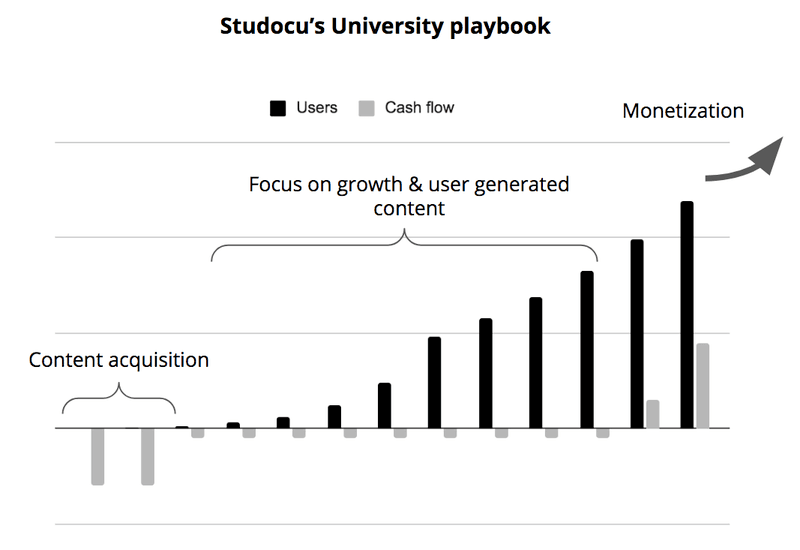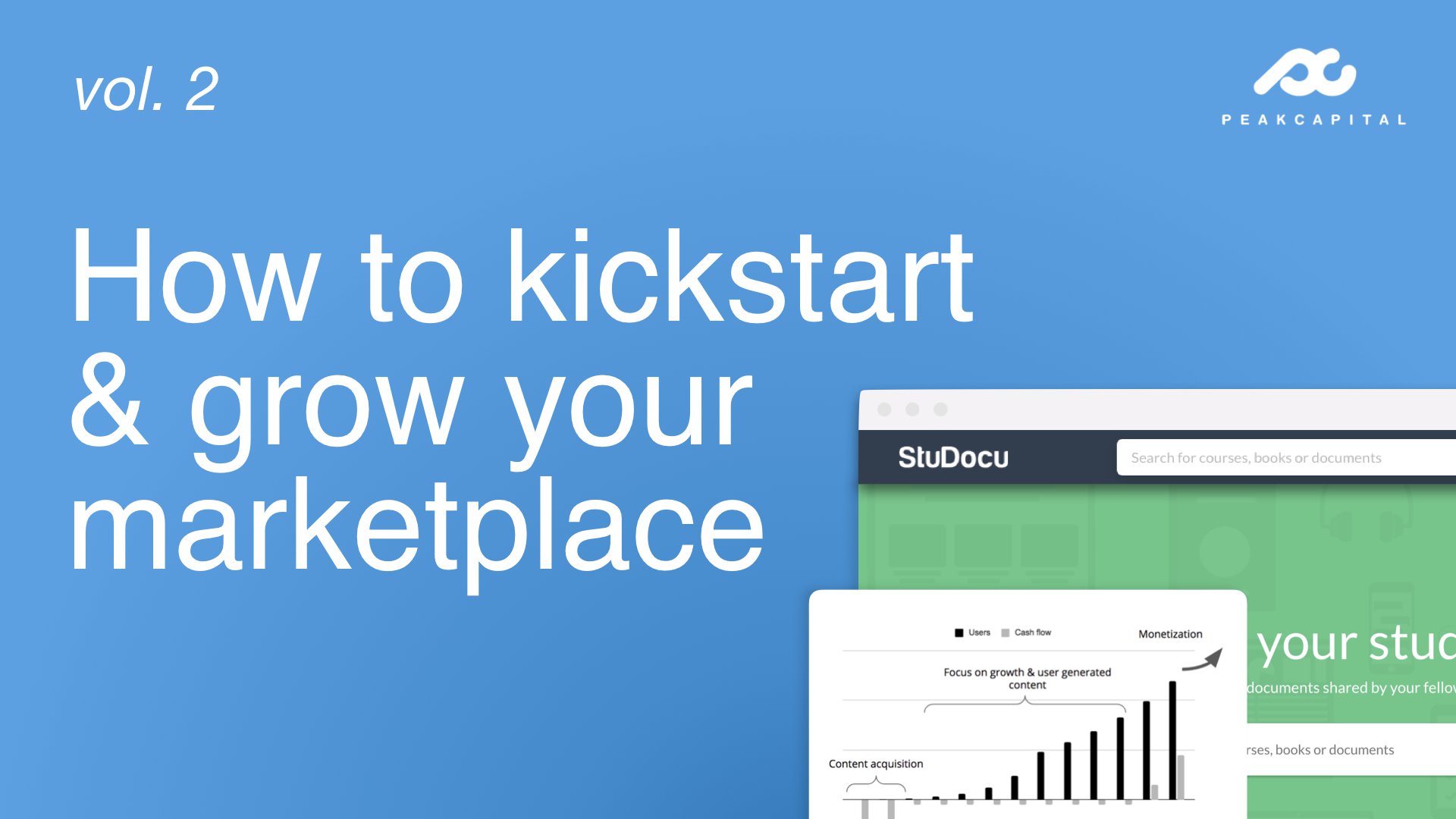The chicken and egg problem is a problem every marketplace founder has to face. As Marketplace investors at Peak, we have seen many founders both succeed and fail to kickstart their marketplace. We believe in learning by doing and are excited to share with you the top strategies from our marketplace founders on how to solve the chicken-and-egg problem.
In this edition: StuDocu opens up about how they solved the chicken-and-egg *multiple times* and by doing so, created a super capital efficient model to scale their business.
Check out earlier strategies! Read Creative Fabrica’s story about doing non-scalable things, innovative revenue models, and using data as a growth loop here.
Without further ado, let’s dive into this one.
StuDocu – Using their personal network, building self-sustaining platforms, and developing a growth playbook.

The company: StuDocu offers a platform where students share their study material to support fellow students in their studies. The platform is based on a freemium model, it consists of 80% free content and 20% premium content. To access the content, students either have to pay a monthly fee or contribute with their own documents, like summaries and lecture notes. Today StuDocu is active at over 2000 Universities and has over 12mio Monthly active users.
In scaling their company, StuDocu faced a couple of challenges:
- The incentive to share – StuDocu had to figure out how they continuously get the best content for every subject.
- Willingness to pay – Students have a low willingness to pay so both StuDocu’s acquisition of supply and their acquisition for growth had to be capital efficient.
- Being a hyper-local platform – Every University is its own ecosystem with limited global network effects on the supply side. Therefore StuDocu had to solve the chicken & the egg multiple times.
👞#1: Leveraging your existing network to kickstart the marketplace
At the time being students themselves, the founders started by leveraging their own network, asking fellow students to put their content on the website for free. While this strategy worked for their direct network, it was less effective with 2nd and 3rd-degree network; students became more hesitant in sharing their personal notes. When they exhausted their personal network and goodwill, the StuDocu team had to think of other incentives for students to share their content.
📚#2: Paying for marketplace supply
After StuDocu reached the edge of their own network, StuDocu couldn’t rely on Students sharing their summaries only for good karma. They had to create an incentive for students to share their content. Note you can use various incentives to grow your supply, what matters is the profile of the suppliers and the nature of the supply. In this case, students are notoriously cost-sensitive and gifts as incentives are an effective fit.
StuDocu started incentivizing by letting students participate in lotteries for winning prices, like an iPhone – which was very popular at that time 😉

While this strategy worked at a small scale a problem arose. The cost per document dramatically decreased the profit margin Thus StuDocu went back to the drawing board to figure out how to solve this issue. Now comes the interesting part….
💎#3: User-generated content
To reduce the acquisition cost per document, StuDocu invented a cost-free way to acquire quality content. To access premium content, users were given a choice: either pay a monthly fee or contribute by sharing your own study materials. A significant amount of students chose to contribute by sharing their summaries, which increased the supply side of the platform. The new content drove other students to the platform and this strategy provided itself as a self-sustainable growth engine. The user-generated content increased the urgency of an efficient content curation engine. That is why Studocu developed a completely automated content curation engine. Without having to pay for content and using the virality of the platform at the university their business became highly capital efficient.
💸#4: Monetization
When a university reaches a significant amount of active users, StuDocu switches to the monetization phase. They adjust the choices of the sign-up funnel by emphasizing the contribution by paying while reducing the sign-up funnel to document contribution. This way it increases the conversion to paid while still getting enough content and new signups. The process of reaching that scale takes a while but after this investment, a highly profitable, (almost) self-sustaining ecosystem is born.
📈#5: “The University growth playbook”
The above strategy worked well to secure student adoption in the first universities. However, StuDocu made one mistake when they launched new universities. They went to new universities with the platform configured to the monetization phase. This resulted in slow growth at these universities. So what did they do wrong?
StuDocu made the mistake that they didn’t reach the critical mass first before they introduced the monetization model. They first had to reach a significant amount of usage on the platform before they could push for monetization. The founders went back to the drawing board and came up with a university playbook, that looks at how to kickstart every university individually.

This process takes time but the profitability of the university after a few years is worth the investment. With currently just 130 universities in monetization while over 2000 universities are launched, we see a massive growth opportunity.
Our main takeaways:
1. Use your network to kickstart your supply – hustle, hustle, hustle.
StuDocu made excellent use of their network. In the early days of the platform, the founders hustled their way to unlock quality supply on goodwill and karma. At later stages, they could use the cash-generating universities to kickstart new ones.
2. The chicken & egg problem will come back to haunt you. Think long-term. Be ready with a playbook.
Because marketplace ecosystems are not always interconnected (Global network effects vs Root density network effects), many marketplaces will face the chicken & egg problem multiple times. A classic example is Airbnb: every traveler benefits from a new house owner worldwide. Whereas Uber has to scale its supply for every city separately. The same holds for StuDocu since its supply is different in Universities because of different languages, courses, and study material.
StuDocu made an excellent University growth playbook to kickstart new marketplaces. The key to such a playbook is to
- Think about what kickstarted your marketplace in the first place.
- Place new assumptions to enhance that strategy
- Test, test, test, and test, even more, to learn which tactics improve your playbook.
Which gives us the final takeaway…
3. Continuously test, measure, and learn.
What continues to impress us about the StuDocu team is their ability to learn. The team continuously comes up with new growth tactics. They A/B test these assumptions on different universities and use the data to support their hypothesis. This way StuDocu continuously learns and improves its growth strategy. Here are some of the tools our founders use: optimizely, mixpanel, amplitude, hotjar.
Curious about what we think of your Marketplace? Shoot us a message and we will provide you with feedback within a week!
